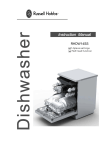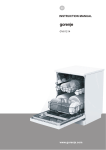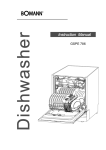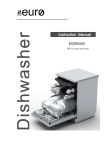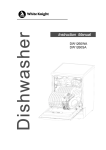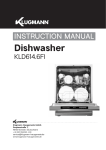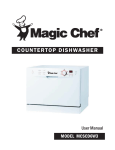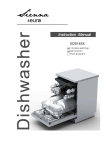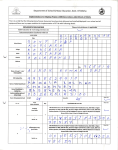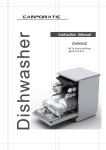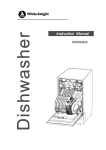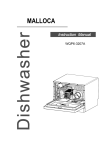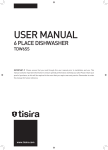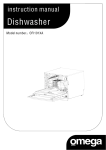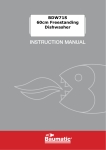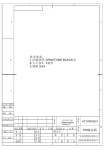Download WQP12-J7309K
Transcript
WQP12-J7309K 14place settings Dear Customer, Please carefully read this manual bef ore using the dishwasher, it will help you to use and maintain the dishwasher properly. Keep it to refer to it at a later date. Pass it on to any subsequent owner of the appliance. This manual contains sections on safety Instructions, Operating Instructions, Installation Instruc tions and Troubleshooting Tips, etc. Contro l Pan el...................................................3 Dishwasher Features.................................... ...3 A 、Water Softener..................... ......... ........ .....4 B、Loading the Salt into the Softener.................5 C、Fill the Rinse Aid Dispenser.........................5 D、Function of Detergent .................................6 Attention before or after loading the Dishwasher Ba skets..........................................................9 The Method Loading Normal Dishware.............10 To review the section on troubleshooting Tips will help you to solve some common problems by yourself . If you can not solv e the problems by yourself , please ask for the help of professional technicians. Wash Cycle Table...........................................11 Turning on the Appliance................................12 Change the Programme.................. ................12 At the end of the Wash Cycle...........................12 Filtering System.............................................13 Caring for the Dishwasher..................... . .........14 The manufacturer, following a policy of con stant dev elopment and updating of the product, may make modifications witho ut giving prior notice. Positioning the Applian ce................... .. ..........15 About Power Connection........................ . .......15 Water Connec tion.................................. . .......1 6 Start of dishwasher................................ .. ......17 This user manual shall also be got from the manufacturer or responsible vendor. Before calling for service........................... . .....18 Error codes.................................... . ..............19 Technical information.............................. .. .....20 When using your dishwasher, follow the precautions listed below: This appliance is intended to be used in household and similar applications such as: -staff kitchen areas in shops, offices and other working environments; -farm houses; -by clients in hotels, motels and other residential type environments; -bed and breakfast type environments. This appliance can be used by children aged from 8 years and above and persons with reduced physical, sensory or mental capabilities or lack of experience and knowledge if they have been given supervision or instruction concerning use of the appliance in a safe way and understand the hazards involved. Children shall not play with the appliance. Cleaning and user maintenance shall not be made by children without supervision.(For EN60335-1 ) This appliance is not intended for use by persons (including children )with reduced physical, sensory or mental capabilities, or lack of experience and knowledge ,unless they have been given supervision or instruction concerning use of the appliance by a person responsible for their safety.(For IEC60335-1 ) This appliance is for indoor use only, for household use only. To protect against the risk of electrical shock, do not immerse the unit, cord or plug in water or other liquid. Please unplug before cleaning and maintenance the appliance . Use a soft cloth moisten with mild soap, and then use a dry cloth to wipe it again. This appliance must be earthed. In the event of a malfunction or breakdown, earthing will reduce the risk of an electric shock by providing a path of least resistance of electric current. This appliance is equipped with a cord having an equipment-earthing conductor and a grounding plug. The plug must be plugged into an appropriate outlet that is installed and earthed in accordance with all local codes and ordinances. Improper connection of the equipment-earthing conductor can result in the risk of an electric shock. Check with a qualified electrician or service representative if you are in doubt whether the appliance is properly grounded. Do not modify the plug provided with the appliance; If it does not fit the outlet. Have a proper outlet installed by a qualified electrician. Do not abuse, sit on, or stand on the door or dish rack of the dishwasher. Do not operate your dishwasher unless all enclosure panels are properly in place. Open the door very carefully if the dishwasher is operating, there is a risk of water squirting out. Do not place any heavy objects on or stand on the door when it is open. The appliance could tip forward. When loading items to be washed: 1) Locate sharp items so that they are not likely to damage the door seal; 2) Warning: Knives and other utensils with sharp points must be loaded in the basket with their points down or placed in a horizontal position. Check that the detergent powder is empty after completion of the wash cycle. Do not wash plastic items unless they are marked dishwasher safe or the equivalent. For plastic items not so marked, check the manufacturer's recommendations. Use only detergent and rinse additives designed for an automatic dishwasher. Never use soap, laundry detergent, or hand washing detergent in your dishwasher. Children should be supervised to ensure that they do not play with the appliance. The door should not be left open, since this could increase the risk of tripping. If the supply cord is damaged, it must be replaced by the manufacturer or its service agent or a similarly qualified person in order to avoid a hazard. During installation, the power supply must not be excessively or dangerously bent or flattened. Do not tamper with controls. The appliance is to be connected to the water mains using new hose sets and that old hose-sets should not be reused. The maximum number of place settings to be washed is 14. The maximum permissible inlet water pressure is 1MPa. The minimum permissible inlet water pressure is 0.04MPa. Dispose of the dishwasher packaging material correctly. All packaging materials can be recycled. Plastic parts are marked with the standard international abbreviations: PE for polyethylene, e.g. sheet wrapping material PS for polystyrene, e.g. padding material POM polyoxymethylene, e.g. plastic clips PP polypropylene, e.g. Salt filler ABS Acrylonitrile Butadiene Styrene, e.g. Control Panel . Packaging material could be dangerous for children! For disposing of package and the appliance please go to a recycling centre. Therefore cut off the power supply cable and make the door closing device unusable. Cardboard packaging is manufactured from recycled paper and should be disposed in the waste paper collection for recycling. By ensuring this product is disposed of correctly, you will help prevent potential negative consequences for the environment and human health, which could otherwise be caused by inappropriate waste handling of this product. For more detailed information about recycling of this product, please contact your local city office and your household waste disposal service. DISPOSAL: Do not dispose this product as unsorted municipal waste. Collection of such waste separately for special treatment is necessary. For detailed operating method read the corresponding content on the instruction manual. Switch on the appliance Fill the detergent dispenser Check the rinse aid level Check the regeneration salt level Load the baskets Select a programme Press the Power switch button to switch on the appliance, Open the door. With each wash cycle. Compartment For programmes with pre-wash only. (Follow the user instructions!) Electric indicator on control panel (if provided). (On models with water softener system only.) Electric indicator on control panel (if provided). If there is no salt warning light in the control panel (for some models), you can estimate when to fill the salt into the softener by the number of cycles the dishwasher has run. Scrape off any large amount of leftover food. Soften remnants of burnt food in pans, then load the baskets. Refer to the dishwasher loading instructions. Close the door,Press the programme button until the selected programme lights up. ( See the section entitled“Operation instruction”) Running the dishwasher T urn on the water tap and press the Start/Pause button. The machine will start working after about 10 seconds. Changing the programme 1. A running cycle can only be modified if it has been running for a short time. Otherwise the detergent may have already been released and the water already drained. If this is the case, the detergent dispenser must be refilled. 2. Press the Start/Pause button ,than press the program button more than 3 seconds to cancel the running programme. 3. Select a new programme. 4. Restart the dishwasher. Add forgotten dishes in the dishwasher. 1.Press the start/pause button to stop the machine. 2.Open the door. 3.Add the forgotten dishes. 4.Close the door, then press the start/pause button, the dishwasher will start running again after 10 seconds. If the appliance is switched off during a wash cycle. If the appliance is switched off during a wash cycle, when switched on again, please re-select the washing cycle and operate the dishwasher according to the original Power-on state ). Switch off the appliance When the working cycle has finished, the buzzer of the dishwasher will sound 8 times, then stop. Turn off the appliance using the Power button. Turn off the water tap, unload the baskets Open the doo r carefully. Hot steam may esc ape when the door is opened! Warning: wait a few minutes (about 15 minutes) before unloading the dishwasher to avoid handling the dishes and utensils while they are still hot and more susceptible to break. They will also dry better.Unload the appliance, starting from the lower basket. To get the best performance from your dishwasher, read all operating instructions before using it for the first time. 1.On/Off Button: to switch On/Off the appliance. 2.Display screen: to show the reminding time and the sta te(running state, delay time,error codes etc ) 9.Program indicators: To show which program you have choosed. 3.Dela y Button : Press the button to add the delay time. 10.Extra Drying fu nction indicator: 4.Extra Drying button : To Press the button to select Ex tra Drying function. 11.Child lock function indic ator: 8.Alt function indicator: 5.Prog ram Button : To Press the button to select appropriate Program. 6.Alt Button: Dual zone wash fu nction, press the button to sele ct either upp er basket or lower basket loa ded, and the response indicators will ligh t on. 7.Start /Pause button: To start the selected washing program o r pause the washing program when the machine is working. Ba ck View Front view 1 2 3 8 4 5 9 6 10 7 12 11 13 1 2 3 Top spray arm Cutlery ra ck Upper basket 4 5 6 Inner pipe Lower basket Salt container 7 8 9 3 Dispenser Cup shelf Spray arms 10 11 12 Filter assembly 13 Adjuster Inlet pipe conne ctor Drain pipe Before using your dishwasher for the first time: A. Set the water softener B. Add 1.5Kg dishwasher salt and then full fill the salt container with water C. Fill the rinse aid dispenser D. Fill in detergent The water softener must be set manually, using the water hardness dial. The water softener is designed to remove minerals and salts from the water, which would have a detrimental or adverse effect on the operation of the appliance. The higher the content of these minerals and salts, the harder your water is. The softener should be adjusted according to the hard ness of the water in your area. Your local Water Authority can advise you on the hardness o f the water in your area. Adjusting Salt Consumption The dishwasher is designed to allow for adjustment in the amount of sa lt co nsumed bas ed on the ha rdness of the water used. This is intended to optimise and customise the level o f salt consumption. Please follo w the steps below for adjustment in salt consumption. 1. Switch on the appliance; 2. Press the Start/Pause button for more than 5 secon ds to start th e water softener set model within 60seconds after the appliance was switched on( The Salt and Rinse aid warning lights will be on periodically when it g et in the set model ); 3. Press the Start/Pause button to select the proper set according to your local environment, th e sets will change in the follo wing sequence: H1->H2->H3->H4->H5-> H6; 4. Press the Power button to end the set up model. WATER HARDNESS dH fH Clarke mmol/l 0~5 0~9 0~6 6-11 10-20 7-14 1.0-2.0 12-17 21-30 15-21 0~0.94 Selector Position Salt consumption (gram/cycle) H1 0 H2 9 2.1-3.0 H3 12 20 18-22 31-40 22-28 3.1-4.0 H4 23-34 41-60 29-42 4.1-6.0 H5 30 35-55 61-98 43-69 6.1-9.8 H6 60 1 dH=1.25 Clarke=1.78 fH=0.178mmol/l DH: German degree fH: French degree Clark: British degree The manufactory setting: H4 (EN 50242) Contact your local water board for information on the hardness of your water supply. If your model does not have any water softener, you may skip this section. WATER SOFTENER The hardness of the wa ter varies from place to plac e. If hard water is used in the dishwasher, de posits will form on the dish es and utensils. The appliance is equipped with a special softener that uses a salt container specifically des igned to eliminate lime and minera ls from the water. Always use the salt intended for use with dishwasher. The salt contain er is located beneath the lower basket and should be fill ed as explained in t he foll owing: Attention! Only use salt spe cif ically desi gne d for t he use i n dishwashers! Every other type of salt not speci fically de sig ned fo r the u se in a d ishwasher, espe cially table salt, will damage the w ater sof tener. In case of damages caused by the use of unsuitable salt the ma nuf act urer does not give any wa rranty nor is liable for any damages caused. Only fil l wi th salt just b efore starting one of the co mp let e washing p rograms. This wi ll prevent any g rains of salt or salty wate r, which ma y have been spilled, remaining on the bottom of the machi ne for any period of time, which may cause corrosi on. A After the lower basket has been removed, unscrew and remove the cap from the salt container. B Place the end of the funnel (supplied) into the hole and introduce about 1.5kg of dishwasher salt. C Full fill the salt container with water,It is normal for a small amount of water to come out of the salt container. D After filling the container , screw the cap tightly back clockwise. E The salt warning light will stop being after the salt container has been filled with salt. F Immediately after filling the salt into the salt container, a washing program should be started (We suggest to use a short program ). Otherwise the filter system, pump or other important parts of the machine may be damaged by salty water. This is out of warranty. 1. The salt container must only be refilled when the salt warning light in the control panel comes on. Depending on how well the salt dissolve s, the salt warning light may still be on even though the salt container is filled. If there is no salt warning light in the con trol panel (for some Mode ls),you can estimate when to fill the salt into the softener by the cycles that the dishwasher has run. 2. If there are spills of the salt, a soak or a rapid program should be run to remove the excessive sa lt. Rinse Aid Dispenser The rinse aid is released during the final rinse to prevent water from forming droplets on your dishes, which can leave spots and streaks. It also improves drying by allowing water to roll off the dishes. Your dishwasher is designed to use liquid rins e aids. The rinse aid dispenser is located inside the door next to the detergent dispenser. To fill the dispenser, open the cap and pour the rinse aid into the dispenser until the level indicator turns completely black. The volume of the rinse aid container is about 110ml. Function of Rinse Aid Rinse aid is automatically added during the last rinse, ensuring thorough rinsing, and spot and streak free drying. Attention! Only use branded rinse aid for dishwasher. Never fill the rinse aid dispenser with any other substances (e.g. Dishwasher cleaning agent, liquid detergent). This would damage the appliance. 5 When to Refill the Rinse Aid Dispenser If there is no rinse-aid warning light in the control panel, you can estimate the amount from the colour of the optical level indicator " C "located next to the cap. When th e rinse-aid c ontainer is full, the whole indicator will be dark .As the rinse -aid diminishes, the size of the dark dot decreases. You should never let the rinse aid leve l fall 1 / 4 full. As the rinse aid d iminishes, the size o f the black dot on the rinse aid level indicator changes, as illustra ted below. Full 3 / 4 full 1 / 2 full 1 / 4 full - Should refill to eliminate spotting Empty 1 2 3 To open the dispenser, turn the cap to the "open" (left) arrow and lift it out. Pour the rinse aid into the dispenser, being careful not to overfill. Replace the cap by inserting it aligned with "open" arrow and turning it to the closed (right) arrow. Clean up any rinse aid spilled while during filling with an absorbent cloth to avoid excessive foaming during the next wash. Don't forget to replace the cap before you close dis hwa sher door. Adjusting Rinse Aid Dispenser The rinse aid dispenser has six or four settings. Always start with the dispenser set on "4". If spots and poor drying are a p roblem, increase the amount of rinse aid dispensed by removing the dispenser lid and rotating the dial to "5". If the dishes still are not drying properly or are show spots, adjust the dial to the next higher lever until your dishes are spot-free. The recommended setting is "4". (Factory value is "4".) Increase the dose if there are drops of water or lime spots on the dishes after washing. Reduce it if there are sticky whitis h stains on your dishes or a bluish film on glassware or knife blades. Detergents with its chemical ingredients are necessary to remove dirt, c rush dirt and transport it out of the dishwasher. Most of the commercial quality deterge nts are suitable for this purpose. Attention! Proper Use of Detergent Use only detergent specifically made for the use in dishwashers. Keep your detergent fresh and dry. Don't put powdered detergent into the dispenser u ntil you're re ady to wash dish es. 6 Detergents There are 3 sorts of d etergents 1.With phosphate and with ch lorine 2.With phosphate and without chlorine 3.Without phosphate and without chlorine Normally new pulverised detergent is with out phosphate. Thus the water softener function of phosphate is not given. In this case we recommend to fill salt in the salt con taine r even when the hardness of water is only 6 °dH. If dete rgents witho ut phosphate are used in the case of hard water often white spots appear on d ishes and glasses. In this case please add more detergent to reach better results. Detergents without chlorine do only bleach a little. Stron g and coloured spots will not be removed completely. In this case please choose a program with a higher temperature. Concentrated Detergent Based on their chemical composition, deterge nts can be split in two basic types: conventional, alkaline dete rgents with caus tic comp onents low alkalin e co ncentrated detergen ts with n atural enzymes Detergent Tablets Detergent tablets of diffe rent brands disso lve at different speeds. For this reason some detergent tablets cannot dissolve and develop the ir full cleaning power during short programs. There fore please use long programs wh en u sin g deterg ent tablets, to ensure the complete removal of detergent residua ls. Detergent Dispenser The dispenser must be refilled before the start of each wash cycle following the instructions provided in the wash cycle table . Your dis hwa sher uses less de tergent and rinse aid than Conventional dis hwa sher. Generally, only one tablespoon of detergent is needed for a normal wash load. More heavily soiled items need more detergent. Alway s ad d the detergent just be fore starting the dish was her, otherwise it could get damp and will not dissolve properly. Amount of Detergent to Use Detergent powder Detergent tablet If the lid is closed: press release button. T he lid will sp ring open. Always add the detergent just before starting each wash cycle. Only use branded detergent aid for dishwasher. Dishwasher detergent is corrosive! Take care to keep it out of reach of children. 7 Fill in Detergent Fill the detergent dispenser with detergent. The marking indicate s the dosing levels , as illustrate d on the righ t: A The place of main wash cycle deterg ent placed. B The place of pre-wash cycle deterge nt placed. Plea se o bserve the manufacturers dosing and storage Recommendations as stated on the detergent pac kaging. Close the lid and press until it locks in place. If the dishes are heavily soiled, place an additional detergent do se in the pre-wash detergent chamber. This detergent will take effect during the pre-wash phas e. You find information about the amount o f detergent for th e single programme on the last page . Please aware, tha t according to the level soiling and the specific hardness of water differences are possible. Please observe th e manufacturer's rec ommendations on the de tergent packaging. 8 Consider buying utensils which are identified as dishwasher-proof. Use a mild detergent that is described as 'kind to dishes'. If necessary, seek further information from the detergent manufacturers. For particular items, select a program with as low a temperature as possible. To prevent damage, do not take gla ss a nd c utlery out of the dishwasher immediately after the programme h as ended. Are not suitable Are of limited suitability Cutlery with wooden, horn china or mother-of-pearl handles Plastic items that are not heat resistant Older cutlery with glued parts that are not temperature resistant Bonded cutlery items or dishes Pewter or cooper items Crystal glass Steel items subject to rusting Wooden platters Items made from synthetic fibres Some types of glasses can become dull after a large number of washes Silver and aluminum parts have a tendency to discolour during washing Glazed patterns may fade if machine washed frequently (For best performance of the dishwasher, follow these loading guide lines. Features and appearance of baskets and cutlery baskets may vary from your model.) Scrape off any large amounts o f leftover food. Soften remnants of burnt food in pans. It is not necess ary to rinse the d ishes under running water. Place objects in the dishwasher in following way: 1.Items such as cups, glasses, pots /pans, etc. are faced downwards. 2.Curved items, or ones with recesses, should be loaded aslant so that water can run off. 3.All utensils are stacked securely and can not tip over. 4.All utensils are placed in the way that the spray arms can rotate freely during washing. Very small items should not be washed in the dishwasher as they could easily fall out of the basket. Load hollow items suc h as cup s, glasses, pans etc. With the opening facing downwards so that water can not collect in the con tainer or a deep b ase. Dishes and items of cutlery must not lie ins ide one another, or cover each oth er. To avoid damage to glasse s, th ey must not touc h. Load large ite ms which are most difficult to clea n into the lower bask et. The upper basket is designed to ho ld more delicate and lighter dishware such as glasses , coffee and tea cups Long bladed knives stored in an upright position are a potential haza rd! Long and/or sharp items o f cutlery such as carving kniv es must be positioned horizonta lly in the upper b asket. Please do not ove rload yo ur dishwasher. This is important for good results and for reasonab le consumption of energy. To prevent water dripping from the uppe r basket into the lower basket, we recommend that you empty the lower basket first and then the upper basket. 9 The u pper basket is designed to hold more delicate and lighter dishware such as glasses, coffee and tea cups and saucers, as well as plates, small bowls and shallow pans (as long as they are not too dirty). Position the dishe s an d co okware so that they will not get moved by the spray of wate r. We suggest that you place large items and the most difficult to clea n ite ms are to be placed into the lo wer basket: such as pots, pans, lids, se rving dishes and bowls, as shown in the figure below. It is pre ferable to place serving dishes and lids on the side of the rack s in order to avoid blocking the ro tation of the top spray arm. Please be reminded that: Pots, serving bowls, etc, must always be placed top down. Deep pots should be slan ted to allow water to flow out. The Botto m Basket features fo lding spikes so that larger or more pots and pans can be loaded. Adjusting the Upper Basket Folding back the cup shelives The height of the upper basket can be adjusted in order to create mo re space for large utensils both for the upper /lower basket. The height of the upper basket can b e adjusted by placing the wheels on different height of the rails. Long items, serving cutlery, salad servers and knives should be placed on the shelf so that they do not obstruct the ro tation of the spray arms.. Fo r better stacking of po ts and pans, the spikes c an b e folded down as sho w in the picture right. Folding Spikes of Lower Basket Fo r better stacking of pots and pans, the spikes can be folded down as show in the picture right. Cutlery should be pla ced in the cutlery rack se parately from each other in th e ap propriate po sitions, and d o make sure the utensils do not nes t together, this may cause bad performance. Fo r a top quality cleaning, place the silverware in the baske t ma king sure that: They do not nes t together. Silverware is placed with the male face up. Lon g utensils in the middle. Do not let any item extend through the bottom. Always load sharp utensils with the sharp point down! 10 ( ) Means: need to fill rinse into the Rinse-Aid Dispenser. Pre-wash(50 ℃) For heaviest soiled crockery, Wash (65 ℃) Rinse and normally soiled pots、 Rinse pans、dishes etc with dried Rinse(55℃) on soiling. Drying Pre-wash(45 ℃) For normally soiled loads, Wash (55 ℃) such as pots、plates、 Rinse glasses and lightly Rinse (65 ℃) soiled pans. Drying This is standard programme, it is suitable to clean normally Pre-wash soiled tableware and it is the Wash (50 ℃) most efficient programme in Rinse(60℃) (*EN 50242) terms of its combined energy Drying and water consumption for that type of tableware. For lightly soiled crockery and glass. For lightly soiled loads that do not need excellent drying efficiency. Pre-wash Wash (40 ℃) Rinse Rinse(60℃) Drying 5/30g 165 1.5 17 5/30g 180 1.3 14 5/30g 175 0.93 10 5/30g 115 0.87 14 5/30g 60 1.15 10 20g 40 0.6 10 8 0.01 3.5 Pre-wash (50℃) Wash(60℃) Rinse (60℃) Drying A shorter wash for lightly soiled loads and quick wash. Wash (40 ℃) Rinse Rinse (45 ℃) To rinse dishes that you plan to wash later that day. Pre-wash *EN 50242 : This p rogramme is the test cycle. The information for comparability test in accordance with EN 502 42, as follows: Capacity: 14 setting Position Upper ba sket: upper wheels on rails Rinse aid setting: 6 Pl:0.49w; Po:0.45 w. Starting a cycle wash 1 Draw out the lower and up per basket, load the dishes and push them back. It is commended to load the lower basket first, then the upper one (see the section entitled “Loading the Dishwasher”). 2 Pour in the detergent (see the section entitled“Salt, Detergent and Rinse Aid”). 3 Insert the plug into the socket. The power supply is 220-240 VAC /50 HZ, the specification of the socket is 10A 250VAC. Make sure that the water supply is turned on to full pressure. 4 Close the door, press the On/Off button to switch on the machine. 5 Press the program button , the wash program will be changed as follows direction: Intensive->Normal->ECO->Glass -> ->Rapid ->Soak ; If a program is selected, the response light will light on. Then press the Start/Pause button, th e dishwasher begins to start. If you want to improve the drying efficiency, you can press the Extra Drying button to select extra drying function before th e dishwasher begins to start. (Rap id and Soak exclusion) 11 When you press the Start/Pause button to pause during washing, the LED display window“ will stop blinking and the dishwasher will mooing every minute unless you press the Start/Pause button to start. ” Premise: A cycle that is underway can only be modified if it ha s only been running for a short time. Otherwise, the detergent may have already been released, and the appliance may have already drained the wash water. If this is the case, the detergent dispenser must be refilled (see the section entitled " Load ing the Detergent " ). 2 Press the Start/Pause button , the machine will be in standby state, press the program button more than 3s then you can change the program to the desired cycle setting (see the section entitled " Starting a wash cycle. . ." ). 3 The LED display shows the state of the dishwasher: 1 a) The Screen sho ws ' H : MM ' and the colon ico n not blinking------------------Stand by or Being paused b) The Screen sho ws ' H : MM ' and the colon ico n blinking-----------------------Running If you open the door during a wash cycle , the machine will pause. the LED display window“ ”will stop blinking and the buzzer will mooing every minute unless you close the door . After you close the door ,the machine will keep on working after 10 seconds. If your model has broken remember function, the machine will go on to finish the selected program after the power cut . A forgotten dish can be added any time before the detergent cup opens. 4 Add forgotten dishes. 1 Press the Start/Pause Button to stop the washing. 2 Open the door a little . 5 Close the door the spray arms stop working, you can open the door 3 After completely. 6 Press the Start/Pause Button, the dishwasher will run after 10 seconds. When the wo rking cycle has finished, the buzzer of the dishwasher will sound for 8 seconds, then stop. Turn off the appliance using the ON/OFF button, shut off the water supp ly and open the door of the dishwasher. Wait for a few minutes before unlo ading th e dishwasher to avoid ha ndlin g the dishes and utensils while they are still hot and more susceptible to break age. The y will also dry better. Switch Off the Dishwasher The Led screen is on but the colon icon is not blinking, only in this case the programme has ended. 1.Switch off the dishwasher by pressing the ON/OFF button. 2.Turn off the water tap! Open the door carefully. Hot dishes are sensitive to knocks. The dishes should therefore be allowed to cool down around 15 minutes before removing from the appliance. Open the dishwasher's door, leave it ajar and wait a few minutes before removing the dishes. In this way they will be cooler and the drying will be improved. Unloading the dishwasher It is normal that the dishwasher is wet inside. Empty the lower basket first and then the upper one. This will avoid water dripping from the upper Basket onto the dishes in the lower one. It is dangerous to open the door when washing, because the hot water may scald you. 12 The filter prevents larger remnants of food or other objects from getting inside the pum. The residues may block the filter, in this case they must be removed. The filter system consists of a coarse filter,a flat (Main filter) And a microfilter(Fine filter). Main filter 2 1 Fo od and soil particles trap ped in this filter are pulverized by a specia l jet on the lower spray arm and washed down to drain. 1 Coarse filter 2 La rger ite ms, such as p ieces of bones or glass, that could block the drain are trapped in the coarse filter. To remove the items caught by the filter, gently squeeze the tap on the top of this filter and lift out. 3 Fine filter 3 This filter holds soil and food residues in the sump area a nd preve nts it from being redeposit on the dishes during wa sh cycle. Filter assembly The filter efficiently re mo ves food particle s from the wash water, allowing it to be rec ycled during the cycle. For best performance and results, the filter must be cleaned re gularly. For this reason, it is a goo d idea to remove the larger food particles trapp ed in the filter after e ach was h cycle by rinsing the semicircular filter and cup under runnin g water. To remove the filter device, pull the cup handle in the upward d irection. The d ishwasher must never b e used without the filters. Improper replacement of the filter may reduce the performance level of the appliance and damage dishes and utensils. 1 Step 1:Turn the filter in anti-clockwise direction, 2 Step 2:lift the filter assy up When following this procedure from step1 to step 2, the filter system will be removed; when following it from Step 2 to Step 1, the filter system will be installed. 13 Remarks: - Inspect the filters for blo cking a fter e very time the dishwa sher has been used. - By unscrewing the coarse filter, you can remove the filter system. Re move any foo d remna nts and clean the filters under running water. The entire filter assembly should be cleaned once a week. Cleaning the Filter To clean the coarse filter and the fine filter, use a c leaning b rush. Reassemb le the filter p arts as shown in the figures on the last page and reinsert the entire assembly in the dis hwa sher, positio ning it in its seat and pressing downwards. When cleaning the filters, don't knock on them. Otherwise, the filters could be contorted and the performance of the dishwasher could be decreased. The control panel can be cleaned by using a lightly dampened cloth. After cleaning, make sure to dry it thoroughly. For the exterior, use a good appliance polish wax. Never use sharp objects, scouring pads or harsh cleaners on any part of the dishwasher. Cleaning The Door To clean the e dge around the door, you should use only a soft warm, damp cloth. To avoid pene tration o f wa ter into the door lock and electrical components, do not use a spray cleaner of any kind. Never use a spray cleaner to clean the door panel as it may damage the door loc k and electrical components. Abrasive agents or some paper towels shou ld not be used becau se of the risk of scratching or leaving spots on the stainless steel surface. Protect Against Freezing please take frost protection measures on the dishwasher in winter. Every time a fter washing cycles, please operate as follows: 1.Cut off the electrical power to the dishwasher. 2.Turn off the water supply and disconnect the water inlet pipe from the water valve. 3.Drain the water from the inlet pipe an d water valve. (Use a pan to gather th e water) 4.Reconnect the water inlet pipe to the water valve. 5.Remove the filter at the bottom of the tub and use a sponge to soak up water in the sump. If your dishwasher cannot work because of the ice, please contact professional service persons. Cleaning the Spray Arms It is necessary to clean the spra y arms re gularly fo r hard wate r che micals will clog the sp ray arm jets a nd bearings. To remove the up per spray arm, hold the nut, rotate the arm clockwise to remove it. To remove th e lower spray arm, pull out the spray arm u pwa rd. Wash the arms in soapy and warm water and use a soft brush to clean the jets. Replace them after rinsing them thoroughly. 14 After Every Wash When not in Use for a LongTime After every wash, turn off the water supply to the appliance and leave the door slightly open so that moisture and odours are not trapped inside. It is recommend that you run a was h cy cle with the dishwasher empty an d the n remove the plug from the socket, turn off the wa ter supply and leave the door of the appliance slightly open. This will help the d oor seals to last longer and prevent odours from forming within the appliance. Remove the Plug Before cleaning or performing maintenance, always remove the plug from the socket. Moving the Appliance No Solvents or Abrasive Cleaning To cle an the e xterior a nd rubber p arts of the dishwasher, do not use solvents or abrasive cle aning products. Only use a clo th with warm so apy water. To remove spots o r stains from the surface of the interior, use a cloth da mpened with water a n a little vinegar, o r a cleaning pro duct mad e specifically for dishwashers. Seals One of the factors that cause odours to form in the dishwasher is food that remains trapped in the seals. Periodic cleaning with a damp sponge will prevent this from occurring. Electrical Shock Hazard Disconnect electrical power before installing dishwasher. The installation of the pipes and electrical equipments should be done by professionals. ● If the appliance must be moved, try to keep it in the vertical position. If absolutely necessary, it can be positioned on its back. Failure to do so can result in death or electrical shock. Installation preparation The installation position of dishwasher should be near the existing inlet and drain hoses and power cord. One side of the cabinet sink should be chosen to facilitate the connection of drain hoses of the dishwasher. Note: please check the accompanying installation accessories(hook for aesthetic panel ,screw) 15 Please carefully read the installation instruction. ● Illustrations of cabinet dimensions and installation position of the dishwasher 1 2 Preparations should b e made before moving the dishwasher to the installation place. Choose a place near the sink to facilitate the installation of inlet and drain hoses (see figure 1). If dishwasher is installed at the corner of the cabinet, there should be some sp ace (illustrated in figure 2) when th e door is opened. 【Figure1】 Cabinet dimensions Less than 5mm between the top of dishwasher and cabinet and the outer door aligned to cabinet. 90 ° 90 ° 820mm 580mm Electrical, drain and water supply line 80 entrances 100 Space between cabinet bottom and floor 600 mm 【Figure2】 Dishwasher Minimum space when the door is opened Cabinet Do or of dishw ashe r Minimum space of 50mm ● 1 Aesthetic panel's dimensions and installation The aesthetic wooden panel could be processed according to the Figure 3. 【Figure3】 The aesthetic panel should be processed in accordance with the illustrated dimensions (Unit: mm) 16 2 magical paster A and magical paster B be disjoinedon ,magical paster A on the aesthetic wooden panel and felted magical paster B of the outer door of dishwasher(see f igure 4a). After positioning of the panel , fix the panel onto t he outer door by screws and bolts(See figure 4b) 【Figure4a】 Installation of aesthetic panel 【Figure4b】 Installation of aesthetic wooden panel 1 . take away the four short screws 2 . pin up the fo ur long screws 17 ● Tension adjustment of the door spring The door springs are set at the factory to the proper tension for the outer door. If aesthetic wooden panel are installed, you will have to adjust the door spring tension. Rotate the adjusting screw to drive the adjustor to strain or relax the steel cable (see figure 5). Door spring tension is correct when the door remains horizontal in the fully opened position,yet rises to a close with the slight lift of a finger. 【Figure5】 Tension adjustment of the door spring ● Connection of drain hoses Insert the drain h ose into a drain pipe with a minimum diameter of 40mm, or let it run into the sink, making sure to avoid bending or crimping it. The top of the ho se must be less than 1000mm. Front NOTE The top of the hose must be less than 1000mm. Counter A B Drain pipe φ 40mm 18 Dishwasher installation steps 1 Install the furniture d oor to the outer door of the dishwasher using the brackets provided. Refer to the template for position ing of the brackets. 2 Adjust the tension of the door springs by using an Allen key turning in a clockwise motion to tighten the left and right door springs. Failure to do this c ould cause damage to y our dishwasher (Illustration 2) . 3 Connect the inlet hose to the cold water supply . 4 Connect the drain hose. Refer to diagram . (Figure 6) 5 Connect the power cord . 6 Affix the conden sation strip u nder the work surface of cabinet. Please ensure the condensation strip is flush with edge of work surface. 7 Place the dishwasher into position.(Illustration 4) 8 Level the dishwasher. The rear food can be adjusted from the front of the d ishwasher by turning the Allen screw in the middle of the base of dishwasher use an Allen key (Illustration 5A). To adjust the front feet, use a flat screw driver and turn the front feet until the d ishwasher is level (Illustration 5B). 9 The dishwasher must be secured in place. There are two ways to do this: A. Normal work surface:Put the installation hook into the slot of the side plane and secure it to the work sur face with the wood screws (Illustration 6). B. Marble or granite work top:Fix the side with Screw. (Illustration 7). Figure 7 19 Dishwasher must be level for proper dish rack operation and wash performance. 1 Place a spirit level on door and rack track inside the tub as shown to check that the dishwasher is level. 2 level the dishwasher by adjusting the three levelling legs individually. 3 When level the dishwasher, please pay attention not to let the dishwasher tip over. 【Figure 8】 Illustration of feet adjustment Check level Front to Back NOTE: The maximum adjustment height of the feet is 50 mm. Spirit level Check level si de to side For personal safety: Do not use an extension cord or an adapter plug with this appliance. Do not, under any circumstances, cut or remove the earthing Connection from the power cord. Plea se look at the ra ting label to know the rating voltage and connect the dishwash er to the app ropriate power supp ly. Use the required fuse 10 amp, time delay fuse or circuit breaker rec ommended and provide separate circuit serving only this appliance. Ensure the voltage and frequency of the power be ing corresponds to those on the rating plate. Only insert the plug into an electrical so cket which is earthed properly. If the electrical socket to which the applianc e must be conne cted is not appropriate for the plug , replace the socket, rather than using a adaptors or the like as they could ca use overhea ting and burns. 20 please close the hydrant after using.(For the models: no safety inlet hose.) Connect the cold water supply hose to a thr eaded 3/4(inch) connector and make sure that it is fastened tightly in place. If the water pipes are new or have not been used for an extended period of time, let the water run to make sure that the water is clear. This precaution is needed to avoid the risk of the water inlet to be blocked and damage the appliance. Positioning the Appliance Position the appliance in the desired location. The back should rest against the wall behind it, and the sides, along the adjacent cabinets or walls. The dishwasher is equipped with water supply and drain hoses that can be positioned either to the right or the left sides to facilitate pro per installation. How to Drain Excess Water From Hoses If the sink is 1000 higher from the floor, the exces s water in hoses cannot be drained directly into the sink. It will b e necessary to drain excess water from hoses into a bowl or suitable container that is held outside and lower than the sink. Water Outlet Connect the water d rain hose. The drain hose must be correc tly fitted to av oid wate r leaks. En sure that the water inlet hose is not kinked or s quashed. Extension Hose If you n eed a drain hose extension, make sure to use a similar dra in hose. It must be no longer than 4 metres; o therwise the cleanin g effect o f the dishwasher could be re duced. Syphon Connection Insert the drain hose into a d rain pipe with a minimum diameter of 40mm, or let it run into the sink, making sure to avo id bending o r crimping it. The top of the hose mus t be less than 100 0mm. The following things should be checked before starting the dishwasher. 1 The dishwasher is level and fixed properly 2 The inlet valve is open 3 There is a leakage at the connections of the conducts 4 The wires are tightly connected 5 The power is switched on 6 The inlet and drain hoses are knotted 7 All packing materials and printings should be taken out from the dishwasher After installation, please make sure to keep this manual. The content of this manual is very helpful to the users. 21 Fuse blown, or the circuit breaker acted Replace fuse or reset circuit breaker. Remove any other appliances sharing the same circuit with the dishwasher Power supply is not turned on Make sure the dishwasher is turned on and the door is closed securely. Make sure the power cord is properly plugged into the wall socket. Water pressure is low Check that the water supply is connected properly and the water is turned on. Door of dishwasher not properly closed. Make sure to close the door properly and latch it. Kink in drain hose Check drain hose. Filter clogged Check coarse the filter (see section titled " Cleaning The Filter ") Kitchen sink clogged Check the kitchen sink to make sure it is draining well. If the problem is the kitchen sink not draining ,you may need a plumber rather than a serviceman for dishwashers. Improper detergent Use only the special dishwasher detergent to avoid suds. If this occurs, open the dishwasher and let suds evaporate. Add 1 gallon of cold water to the tub. Close and latch the dishwasher, then select any cycle. Dishwasher will drain out the water at the first step.Open the door after draining is stop and check if the suds is disappeared. Repeat if necessary. Spilled rinse-aid Always wipe up rinse-aid spills immediately. Detergent with colourant was used Make sure that the detergent is the one without colourant. Hard water minerals To clean the interior, use a damp sponge with dishwasher detergent and wear rubber gloves. Never use any other cleaner than dishwasher detergent for the risk of foaming or suds. The affected items are not corrosion resistant. A programme was not Always run the quick wash programme . without any crockery in the dishwasher and run after dishwasher without selecting the Turbo function (if present), salt was added. Traces of salt have after adding dishwasher salt. gotten into the wash cycle. The lid of the softer is loose Check the lip .Ensure the fix is fine. A spray arm is knocking against an item in a basket Interrupt the programme, and rearrange the items which are obstructing the spray arm. Items of crockery are loose in the wash cabinet Interrupt the programme, and rearrange the items of crockery. This may be caused by on-site installation or the cross-section of the piping. This has no influence on the dishwasher function. if in doubt, contact a suitably qualified plumber. 22 The dishes were not loaded correctly. See notes in " Loading the Dishwasher Baskets ". The programme was not powerful enough. Select a more intensive programme. See" Wash Cycle Table ". Not enough detergent was dispensed. Use more detergent, or change your detergent. Items are blocking the path of spray arms. Rearrange the items so that the spray can rotate freely. The filter combination in the base of wash cabinet is not clean or is not correctly fitted. This may cause the spray arm jets to get blocked. Clean and/or fit the filter combination correctly. Clean the spray arm jets. See "Cleaning the Spray Arms". Combination of soft water and too much detergent. Use less detergent if you have soft water and select a shortest cycle to wash the glassware and to get them clean. Aluminum utensils have rubbed against dishes. Use a mild abrasive cleaner to eliminate those marks. Dishes block detergent cups. Re-loading the dishes properly. Improper loading Load the dishwasher as suggested in the directions. Too little rinse-aid Increase the amount of rinse-aid/refill the rinse-aid dispenser. Dishes are removed too soon Empty the lower basket first and then the upper one. This will avoid water dripping fro m the upper Basket onto the dishes in the lower one Wrong program has been selected In short program the washing temperature is lower. This also lowers cleaning performance. Choose a program with a long washing time. Use of cutlery with a low-quality coating Water drainage is more difficult with these items. Cutlery or dishes of this type are not suitable for washing in the dishwasher. When some malfunctions come on, the appliance will display error codes to warn you: E1 Longer inlet time. Faucets is not opened, or water intake is restricted,or water pressure is too low. E4 Overflow. Some element of dishwasher leaks . E8 Failure of orientation of distributary valve. Open circuit or break of distributary valve. If overflow occurs, turn off the main water supply before calling a service. If there is water in the base pan because of an overfill or small leak, the water should be removed before restarting the dishwasher. 23 Height : Width : Depth : Water pressure: Power supply: Capacity: 815mm 598 mm 570mm ( with the door closed ) 0.04-1.0MPa see rating label 14 place settings 24






























